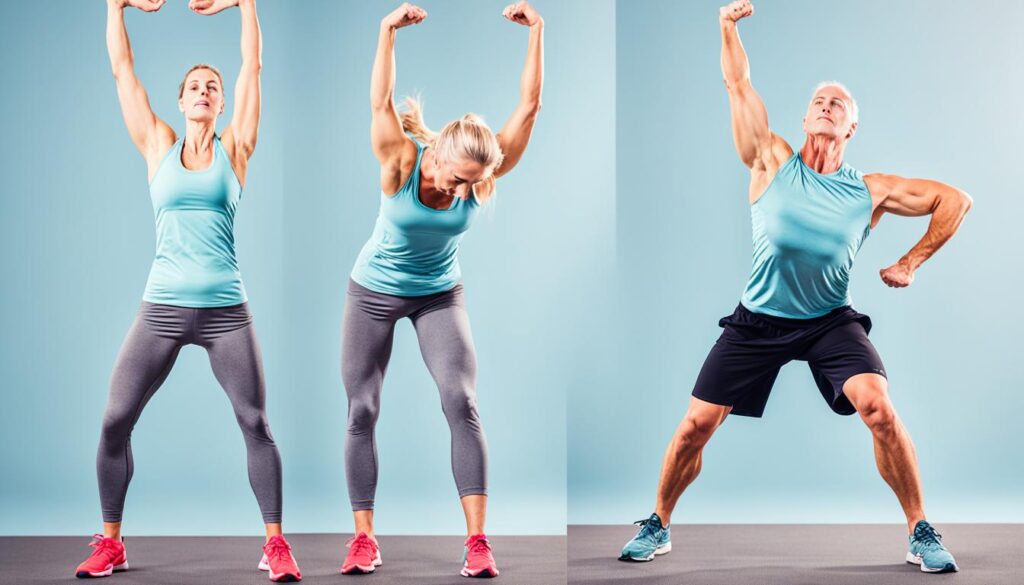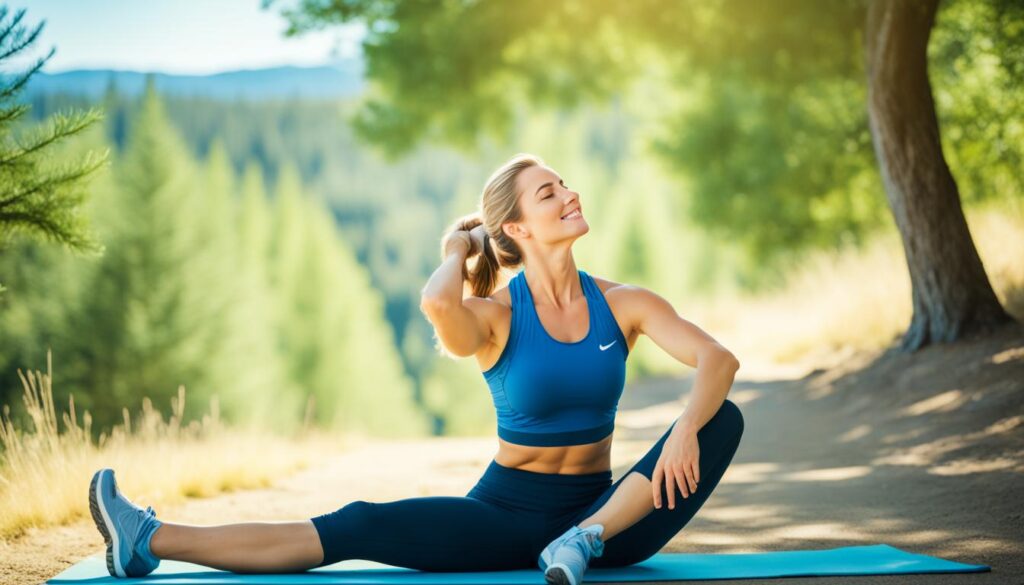Are you maximizing the benefits of your workout routine? The often overlooked steps of proper warm-up and cool-down can make all the difference in your fitness journey1. From preventing injuries to enhancing performance, these essential preparatory and recovery phases are crucial for an effective and safe workout. Dive in to uncover the science-backed reasons why you should never skip them.
Key Takeaways:
- Warm-ups prepare the body for exercise by increasing blood flow, improving oxygen efficiency, and enhancing muscle contraction and relaxation.
- Cool-downs aid recovery and reduce delayed onset muscle soreness (DOMS).
- Skipping warm-up and cool-down can increase injury risk, cause blood pooling, and stress the cardiovascular system.
- Proper warm-up and cool-down routines are essential for all fitness levels and can improve workout performance and adherence.
- Warm-up and cool-down techniques should be tailored to specific sports and adjusted for age and fitness level.
What is the Importance of a Proper Warm-Up and Cool-Down?
Warming up and cooling down are crucial components of an exercise routine. Proper warm-up and cool-down routines play a vital role in optimizing exercise performance, preventing injuries, and promoting faster recovery234.
During the warm-up phase, gradually increasing heart rate, blood flow, and muscle temperature prepares the body for the upcoming physical activity2. This ensures that muscles are well-supplied with oxygen and nutrients, enhancing their ability to contract and function efficiently2. Additionally, proper stretching during the warm-up can decrease muscle pain and stiffness in some individuals2.
Cooling down, on the other hand, helps the body transition from the workout to a resting state2. This gradual decrease in activity is essential for a safe cool-down process, allowing the heart rate and body temperature to slowly return to pre-exercise levels3. Stretching during the cool-down phase can also help reduce the buildup of lactic acid in muscles, aiding recovery and reducing post-exercise discomfort2.
| Warm-Up Benefits | Cool-Down Benefits |
|---|---|
In summary, a proper warm-up and cool-down routine is essential for optimizing exercise performance, reducing the risk of injury, and promoting faster recovery234. By gradually preparing the body for physical activity and transitioning it back to a resting state, these crucial components of an exercise routine can help athletes and fitness enthusiasts alike achieve their goals and maintain overall health and well-being.
Benefits of Warming Up
Warming up can provide numerous benefits for athletes and fitness enthusiasts alike. By preparing the body and mind, a proper warm-up routine can enhance athletic performance, prevent injuries, and mentally prepare individuals for their exercise session5.
Improved Performance
Researchers have found that warming up can significantly improve athletic performance. Studies show that 79% of the exercises reported improved performance after warm-up routines, with the improvement ranging from 1% to 20%5. This is due to the warm-up’s ability to increase blood flow, improve oxygen efficiency, and enhance muscle contraction and relaxation5. Professional athletes, like tennis players, may spend up to an hour warming up before a match to rehearse specific movements in addition to warming up their muscles5.
Injury Prevention
Proper warm-up exercises can also help prevent injuries by loosening joints and preparing the muscles for the upcoming workout. Over 30% of injuries seen in sports medicine clinics are muscular injuries, some of which can be reduced by effective warm-up routines5. For most individuals, a warm-up period of about 10 minutes is recommended to warm muscles and loosen joints effectively5.
Mental Preparation
The warm-up process not only prepares the body physically but can also mentally prepare the individual for the exercise session. By gradually increasing the intensity and rehearsing specific movements, the warm-up can help individuals feel more focused, confident, and ready to perform at their best5.
Incorporating a well-designed warm-up routine into your exercise regimen can lead to improved athletic performance, reduced injury risk, and enhanced mental preparedness for the workout ahead532.
“A good warm-up widens blood vessels, ensuring muscles are well supplied with oxygen.”2
| Benefit | Explanation | Supporting Data |
|---|---|---|
| Improved Performance | Warm-up exercises can increase blood flow, improve oxygen efficiency, and enhance muscle contraction and relaxation, leading to better athletic performance. | 79% of studies reported improved performance after warm-up, with improvements ranging from 1% to 20%5. |
| Injury Prevention | Proper warm-up routines can loosen joints and prepare the muscles for the upcoming workout, reducing the risk of muscular injuries. | Over 30% of injuries seen in sports medicine clinics are muscular injuries, some of which can be reduced by effective warm-up routines5. |
| Mental Preparation | The warm-up process can help individuals feel more focused, confident, and ready to perform at their best. | The gradual increase in intensity and rehearsal of specific movements during the warm-up can mentally prepare the individual for the exercise session5. |
Incorporating a well-designed warm-up routine into your exercise regimen can lead to improved athletic performance, reduced injury risk, and enhanced mental preparedness for the workout ahead532.
Warming Up Prepares the Body
Proper warm-up exercises are crucial for preparing the body before engaging in physical activity6. A well-designed warm-up can last anywhere from 10 minutes to an hour, allowing flexibility based on individual preferences or the intensity of the upcoming workout6. The warm-up typically includes a variety of exercises, such as pulse-raising activities, joint mobility drills, dynamic stretching, and larger dynamic movements, gradually increasing in intensity and speed6. For many athletes, the warm-up also incorporates skill rehearsal, with sport-specific drills like passing, shooting, or practicing technical skills6.
Increases Blood Flow
A proper warm-up increases blood flow to the muscles, ensuring they are well-supplied with oxygen6. This increased blood flow helps prepare the muscles for the demands of the upcoming workout, enhancing their ability to perform at their best6.
Improves Oxygen Efficiency
In addition to improved blood flow, a warm-up also enhances the efficiency of oxygen utilization by the muscles6. This increased oxygen efficiency allows the muscles to work more effectively, reducing the risk of fatigue and improving overall performance6.
Enhances Muscle Contraction and Relaxation
A well-executed warm-up also plays a crucial role in enhancing the muscles’ ability to contract and relax6. This improved muscle function is essential for optimal performance and injury prevention, as it ensures the muscles are ready to work at their full potential6.
By incorporating a comprehensive warm-up routine, individuals can prepare their bodies for the physical demands of their chosen activity, leading to improved performance, reduced injury risk, and a more enjoyable workout experience678.
| Warm-Up Components | Duration and Intensity |
|---|---|
| Pulse-raising activities | 5-7 minutes, progressing from low to moderate intensity7 |
| Joint mobility exercises | Included in warm-up routine6 |
| Dynamic stretching | Incorporated into warm-up6 |
| Larger dynamic movements | Gradually increasing in intensity and speed6 |
| Sport-specific skill rehearsal | Included in warm-up for many athletes6 |
By following a well-designed warm-up routine, individuals can ensure that their bodies are adequately prepared for the physical demands of their chosen activity, leading to improved performance, reduced injury risk, and a more enjoyable workout experience678.
Cooling Down After Exercise
After a workout, it’s important to cool down by gradually reducing the intensity and pace of the exercise. This allows the heart rate and blood pressure to return to their pre-exercise levels, helping the body transition back to a resting state9.
Cooling down is a crucial step in any fitness routine, as it helps the body recover and prepare for the next workout. By gradually reducing the intensity of the exercise, the body can gradually lower its heart rate, improve lung function, and eliminate lactic acid buildup, which can lead to muscle soreness910.
One of the most effective ways to cool down is through a combination of light aerobic activity and static stretching. This can include activities such as walking, light jogging, or cycling at a slower pace, followed by targeted stretches for the major muscle groups used during the workout10.
| Cooling Down Techniques | Benefits |
|---|---|
| Gradual Pace Reduction | Aids in the gradual lowering of heart rate and blood pressure, helping the body transition back to a resting state9. |
| Stretching | Helps reduce muscle soreness and improve flexibility, aiding in the recovery process10. |
| Foam Rolling or Massage | Can enhance the cooling down process by reducing muscle tension and promoting blood flow10. |
Incorporating a proper cool-down routine into your fitness regimen is essential for overall health and performance. By taking the time to gradually wind down after a workout, you can help your body recover, reduce the risk of injury, and improve your overall fitness910.
Remember, a well-designed cool-down routine can make a significant difference in your fitness journey. By listening to your body and implementing the right strategies, you can maximize the benefits of your workouts and continue to progress towards your health and fitness goals91011.
Benefits of Cooling Down
Cooling down after a workout is just as important as the warm-up. The cooling down process helps your body transition from an elevated state of activity to a more relaxed, resting condition. This gradual process offers numerous benefits that can aid your recovery and prepare you for future workouts12.
Aids Recovery
Cooling down can aid the body’s recovery process by helping to remove lactic acid buildup and reduce the severity of delayed onset muscle soreness (DOMS)12. According to a study published in the Journal of Human Kinetics, an aerobic cool-down can help reduce DOMS by improving circulation to remove waste products that may build up in the muscles13. This can keep you feeling more comfortable and allow your body to recover more effectively between workouts.
Reduces Delayed Onset Muscle Soreness (DOMS)
Proper cooling down can help release and remove lactic acid built up during intense exercise, aiding in post-workout recovery12. Completing a cool-down can also reduce the potential for DOMS (delayed onset muscle soreness) which can occur 24 to 48 hours after exercising14. Failure to properly cool down may lead to increased soreness due to lactic acid pooling in muscles14.
Cooling down helps prepare muscles for subsequent exercises, aiding in faster recovery and readiness for future workouts14.
Gradually reducing exercise intensity during the last 10 minutes of a session helps regulate blood flow, vital for endurance sports athletes like long-distance runners12.
Consequences of Skipping Warm-Up and Cool-Down
Failing to warm up and cool down can have serious consequences for your fitness routine and overall health. Skipping these crucial phases can increase the risk of injuries, as the muscles and joints are not properly prepared for the demands of the workout15. It can also lead to blood pooling in the lower extremities, causing dizziness and lightheadedness, and can place unnecessary stress on the cardiovascular system15.
Increased Risk of Injury
Neglecting the warm-up and cool-down phases can significantly increase the risk of sustaining an injury during your workout15. Athletes who skip these routines face a significantly higher risk of injury during workouts or competitions15. An effective warm-up routine typically lasts around 5 minutes and involves activities like jogging or biking to raise body temperature and prepare muscles15. Cool-down exercises should span 5 to 10 minutes post-workout, at a lower intensity, to gradually return heart rate and body temperature to pre-exercise levels15.
Blood Pooling
Failing to properly cool down can lead to blood pooling in the lower extremities, a condition that can cause dizziness and lightheadedness15. Incorporating stretching into the cool-down phase can enhance flexibility, mobility, and reduce post-workout soreness15.
Increased Stress on Cardiovascular System
Skipping the warm-up and cool-down phases can place unnecessary stress on the cardiovascular system15. An essential aspect of warming up is to enhance blood flow, which can help muscles feel less stressed and stiff during intense workouts15.
While the benefits of warm-up and cool-down exercises are well-documented, many individuals still struggle to incorporate these essential components into their fitness routines16. Around 30% of gym-goers skip the warm-up phase due to it not being perceived as exciting, and approximately 45% overlook the cool-down phase due to time constraints16. Lack of knowledge is the primary reason cited by 50% of individuals for excluding warm-up and cool-down from their workouts16.

Proper warm-up and cool-down phases lasting about 10 minutes each are recommended for effective exercise routines16. Dynamic stretching is the most commonly used technique during warm-up, imitating the movements the body will undergo during the workout16. Static stretches during cool-down are held for a prolonged period to increase flexibility and aid in muscle recovery16.
Engaging in a cool-down phase helps in reducing muscle soreness post-workout, as explained by anecdotal evidence16. The warm-up phase is essential to prepare the body for physical demands, while the cool-down phase aids in bringing the heart rate and blood pressure back to normal levels16.
“Skipping warm-up and cool-down routines is a common issue, particularly among athletes pressed for time.”15
Types of Warm-Up Exercises
Preparing your body for a workout is crucial, and incorporating a variety of warm-up exercises can help you get the most out of your fitness routine17. Common warm-up exercises include light jogging, brisk walking, slow cycling, and dynamic stretches that target the major muscle groups used in the upcoming workout17.
- Light jogging or brisk walking can help gradually increase your heart rate and blood flow, preparing your body for more intense exercise17.
- Dynamic stretches, such as leg swings, arm circles, and bodyweight lunges, can improve range of motion and flexibility17.
- Squats, planks, side lunges, pushups, and triceps warmups can help activate and prepare your muscles for a wide range of workout routines17.
Fitness experts recommend spending at least 5 to 10 minutes warming up before exercise17. A dynamic warm-up is designed to prepare the body for higher-intensity workouts, while static stretching is best performed after a workout to improve flexibility and range of motion17.
Some research-backed warm-up exercises include:18
- Squats: Engage the lower body and improve mobility18.
- Calf Raises: Target the calves and improve ankle flexibility18.
- Downward Dog to High Plank: Stretch the shoulders and upper back18.
- Shoulder Rows: Mobilize the shoulders and upper back18.
Incorporating these dynamic warm-up exercises can help boost strength, mobility, and coordination before your workout, while also reducing the risk of injury17. Fitness experts recommend performing 1 to 3 sets of 12 to 15 reps of these exercises during your warm-up routine17.
Additionally, including exercises like jogging leg lifts can help get your heart pumping and improve circulation17. Triceps warmups involving arm circles and pulsing movements for 20 to 30 seconds can also be beneficial17.
“Effects of Warming-up on Physical Performance” published in the Journal of Strength and Conditioning Research offers a systematic review with meta-analysis on the topic18.
Cool-Down Techniques
Effective cool-down techniques involve gradually reducing the pace and intensity of the workout, such as walking after a run or swimming laps at a slower pace3. Stretching during the cool-down can also help alleviate muscle soreness and improve flexibility3.
Gradual Pace Reduction
The cool-down phase should focus on gradually decreasing the intensity of the workout. This can be achieved by engaging in light aerobic activities like brisk walking, easy cycling, or slower-paced swimming3. The goal is to allow the heart rate and blood pressure to slowly return to their pre-exercise levels, preventing dizziness or fainting19.
Stretching While Cooling Down
Incorporating static stretching into the cool-down routine can help reduce muscle tightness and soreness19. The stretches should be held for 10 to 30 seconds, with a focus on the major muscle groups used during the workout2. This allows the muscles to gradually relax and recover, promoting better flexibility and reduced risk of injury19.

By following effective cool-down techniques, individuals can facilitate the recovery process and prepare their bodies for the next workout session3. Integrating a proper cool-down routine into your fitness regimen can be a valuable addition to your overall health and well-being1932.
Importance for Different Fitness Levels
Warm-ups and cool-downs are essential for individuals of all fitness levels, from beginners to elite athletes. Researchers found that 79% of studies reported improved performance after warmups, with the percentage of improvement ranging from 1% to5. However, the duration and intensity of these activities may vary based on the individual’s experience and the type of workout.
For beginners, a longer warm-up and cool-down period may be necessary to gradually prepare the body and prevent potential injuries. Dynamic warm-up has been shown to reduce the risk of injuries compared to static20, and spending 10-20 minutes on a cool-down routine post-exercise helps in repairing muscle tissue, improving recovery, and reducing soreness20.
In contrast, elite athletes may require a more intense warm-up routine to prime their bodies for high-performance activities. Professional athletes typically spend extended periods preparing for a game or contest, such as tennis pros may hit balls for an hour prior to a match, not just to warm up muscles but also to rehearse specific5. The cool-down for these athletes is also crucial to aid in recovery and prevent delayed-onset muscle soreness.
Regardless of fitness level, most people looking to warm muscles and loosen joints require a warm-up period of about 10 minutes for effective preparation5. The cool-down should also be tailored to the individual’s needs, with a focus on low-intensity exercise and targeted stretching.
In summary, warm-ups and cool-downs are essential for individuals of all fitness levels, but the duration and intensity of these activities may vary based on the individual’s experience and the type of workout. Proper warm-up and cool-down routines can help improve performance, prevent injuries, and aid in recovery, making them an integral part of any exercise regimen52021.
Warm-Up and Cool-Down for Specific Sports
When it comes to exercise and physical activity, the warm-up and cool-down routines play a crucial role in optimizing performance and reducing the risk of injury. These routines need to be tailored to the specific demands of different sports and activities, such as running, swimming, or strength training22. Consulting with a fitness professional can help you develop the most effective warm-up and cool-down for your chosen sport or workout.
For runners, a warm-up may include dynamic stretches, light jogging, and high-knees, while a cool-down could involve a gradual pace reduction and static stretching of the leg muscles23. Swimmers might start with arm circles, shoulder rolls, and leg swings, followed by a cool-down of slow laps and gentle stretching. Strength training enthusiasts could benefit from a warm-up focused on mobility exercises, such as body weight squats and lunges, and a cool-down that includes stretching and foam rolling.
Regardless of the sport or activity, the primary goal of the warm-up is to prepare the body for the upcoming physical demands. This includes increasing blood flow, improving oxygen efficiency, and enhancing muscle contraction and relaxation24. The cool-down, on the other hand, aids in recovery by helping to clear lactic acid and other metabolic waste products, as well as reducing the risk of delayed onset muscle soreness (DOMS).
By tailoring the warm-up and cool-down routines to your specific sport or activity, you can maximize the benefits and minimize the risk of injury22. This may involve consulting with a sports physiotherapist or fitness professional who can provide guidance on the most suitable exercises and durations based on your individual needs and the intensity of your workout.

Remember, the warm-up and cool-down are essential components of a well-rounded fitness routine. By taking the time to properly prepare your body before and after your workout, you can enhance your performance, reduce the risk of injury, and support your overall health and well-being222423.
Incorporating Warm-Up and Cool-Down Into Your Routine
Allocating time for a proper warm-up and cool-down is crucial, even if it means adjusting the duration of your main workout3. Incorporating these activities into your routine can help you get the most out of your exercise sessions and reduce the risk of injury3.
When planning your workout, be sure to allot time for a warm-up and cool-down. A typical warm-up might involve 5-10 minutes of light aerobic activity, such as walking or jogging, to gradually increase your heart rate and blood flow15. This prepares your body for more intense exercise and helps reduce the risk of injury15.
After your main workout, it’s essential to cool down for 5-10 minutes15. This allows your heart rate and blood pressure to gradually return to pre-exercise levels, which is particularly important for endurance athletes like marathoners3. Incorporating light aerobic activity and stretching during the cool-down can aid recovery and reduce muscle soreness312.
Remember, proper warm-ups and cool-downs pose little risk and can make a significant difference in your overall fitness and performance3. By taking the time to incorporate these crucial components into your routine, you’ll be well on your way to getting the most out of your workouts and reducing the likelihood of injury3.
| Warm-Up | Cool-Down |
|---|---|
| 5-10 minutes of light aerobic activity, such as walking or jogging, to gradually increase heart rate and blood flow15. | 5-10 minutes of light aerobic activity and stretching to allow heart rate and blood pressure to gradually return to pre-exercise levels315. |
“Proper warmups and cool-downs pose little risk and facilitate a smooth transition into and out of exercise sessions.”3
By incorporating a warm-up and cool-down into your workout routine, you’ll be well on your way to getting the most out of your exercise sessions and reducing the risk of injury3. Remember, the key is to find the right balance and adjust the duration of your warm-up and cool-down as needed to suit your fitness level and the type of exercise you’re doing31215.
Tips for Effective Warm-Up and Cool-Down
Crafting an effective warm-up and cool-down routine is essential for optimizing your workout performance and reducing the risk of injury. Here are some valuable tips to consider:
- Start with large muscle groups: Begin your warm-up by targeting your larger muscle groups, such as your legs and core. This helps increase blood flow and prepare your body for more intense movements2.
- Gradually increase or decrease intensity: During the warm-up, gradually elevate your heart rate and breathing rate to prepare your body for the workout. Similarly, cool down by gradually reducing the intensity to allow your body to return to a resting state2.
- Include both dynamic and static stretching: Dynamic stretches, like walking lunges or jumping jacks, can help improve range of motion and prepare your muscles for the workout. Static stretches, held for 30-45 seconds, are more effective during the cool-down phase25.
Listening to your body and adjusting the duration and intensity of your warm-up and cool-down as needed is also crucial26. Remember, the warm-up should typically last 10-15 minutes to allow your heart rate to rise gradually2.
By following these tips, you can ensure that your warm-up and cool-down routines are tailored to your individual needs and fitness level, helping you perform at your best and reducing the risk of injury. For more information, check out these helpful resources on effective warm-up and cool-down strategies, the benefits of warming up and cooling, and the importance of warm-up and cool-down for heart.
“Proper warm-up and cool-down are essential for achieving peak performance and preventing injuries. Take the time to listen to your body and tailor your routines accordingly.”
By incorporating these tips into your fitness routine, you can maximize the benefits of your workouts and prioritize your overall health and well-being26252.
Adjusting for Age and Fitness Level
The warm-up and cool-down requirements may need to be adjusted based on age and fitness level27. Older adults or individuals with certain health conditions may require a longer warm-up and cool-down to account for decreased flexibility and cardiovascular function27.
As people age, the focus of exercise shifts towards lower-impact activities promoting overall well-being and disease prevention27. Research suggests that exercise protects against chronic conditions more common in older people, including cardiovascular disease, stroke, diabetes, and some forms of cancer27. Balance-focused activities can reduce the risk of falls, while weight-bearing exercises strengthen bones, reducing the impact of osteoporosis27.
Menopausal symptoms like hot flashes, mood swings, and weight gain can be alleviated by moderate cardio and strength training27. Exercise has been shown to boost estrogen levels during menopause, reducing symptoms and risk factors27. Adjusting exercise intensity, clothing choices, and hydration can help manage hormonal fluctuations during menopause27.
Exercise is beneficial for individuals with arthritis, as long as movements don’t cause pain higher than a 5 out of 1027. Aquatic exercises and movements using household objects are recommended for those with arthritis27. Weight-bearing exercises like squats, yoga, and stair climbing can help individuals with osteoporosis build bone strength2728.
Muscle mass loss due to aging can lead to increased fatigue during workouts, countered by regular exercise and stretching27. Gradual strength training, bodyweight exercises, and low-impact classes like yoga or tai chi can improve muscle mass and energy levels27.
Limited mobility can be addressed with support from props like pillows, cushions, or higher surfaces to modify exercises27. Consulting a physical therapist or personal trainer for tailored modifications is recommended for individuals with limited mobility27.
Safety precautions include learning proper gym equipment usage, avoiding crowded spaces with hearing or vision impairments, and consulting healthcare professionals for activity suitability27.
| Exercise Recommendations for Older Adults | Frequency | Duration |
|---|---|---|
| Moderate Aerobic Activity | 150 minutes per week | 20-60 minutes per session |
| Vigorous Aerobic Activity | 75 minutes per week | 20-60 minutes per session |
| Strength Training | 2 or more times per week | – |
| Balance Exercises | – | 30 minutes per session |
The Physical Activity Guidelines for Americans recommend 150 minutes of moderate aerobic exercise per week or 75 minutes of vigorous aerobic activity, with a mix of the two28. Strength training sessions should be included in the routine at least two times per week, with a recovery period of at least 48 hours in between28. Balance exercises are recommended for older adults at risk of falling, with a suggested duration of 30 minutes of balance training28.
Walking is a safe exercise for people of any age or fitness level and can be adjusted by adding time, distance, or hills for endurance improvement28. The recommendation for strengthening exercises is to work on all major muscle groups two or more times a week, with at least 48 hours rest in between28. It is advised to allow at least 48 hours for muscle recovery and repair between strength training sessions to build more muscle and get stronger28.
Training three times a week produces significant training effects29. Training 5 days a week at lower intensity may be more manageable for some individuals29. Little additional benefit is seen with more than five training sessions a week29. Training twice a week does not produce increases in VO2max29. Moderate-intensity aerobic exercise at least 5 days a week or vigorous-intensity exercise done at least 3 days a week is recommended for most adults to achieve and maintain health/fitness benefits29.
Fun is crucial for exercise adherence29. Individuals are more likely to adhere to the exercise program if it involves fun and enjoyment29. The FITT Principle loses its usefulness if an individual does not adhere to their exercise program due to lack of enjoyment29.
“The warm-up and cool-down requirements may need to be adjusted based on age and fitness level. Older adults or individuals with certain health conditions may require a longer warm-up and cool-down to account for decreased flexibility and cardiovascular function.”
Conclusion
Incorporating a proper warm-up and cool-down into your workout routine is essential for optimal performance, injury prevention, and overall health30. By taking the time to prepare your body and allow it to transition back to a resting state, you can improve the effectiveness of your workouts and support your long-term fitness goals30.
Research has shown that a well-designed warm-up can significantly reduce the risk of injury and enhance exercise performance31. Warming up helps to increase blood flow, improve oxygen efficiency, and enhance muscle contraction and relaxation, all of which contribute to a more productive and safer workout31. Similarly, cooling down after exercise aids recovery and reduces delayed-onset muscle soreness, allowing your body to transition back to a resting state more effectively32.
Whether you’re a seasoned athlete or just starting your fitness journey, incorporating a thoughtful warm-up and cool-down into your routine can make a significant difference in your overall fitness and well-being. By prioritizing these essential elements of a complete workout, you’ll be well on your way to achieving your fitness goals and maintaining a healthy, active lifestyle303132.
FAQ
What is the importance of a proper warm-up and cool-down?
Proper warm-up and cool-down are essential for an effective and safe workout routine. Warm-ups prepare the body by increasing blood flow, improving oxygen efficiency, and enhancing muscle contraction and relaxation. Cool-downs help with recovery and reduce delayed onset muscle soreness (DOMS). Skipping these important steps can increase the risk of injury, cause blood pooling, and put unnecessary stress on the cardiovascular system.
What are the benefits of warming up?
Warming up can enhance athletic performance by improving blood flow, oxygen efficiency, and muscle contraction/relaxation. It also helps prevent injuries by loosening joints and preparing muscles for the upcoming workout. Additionally, the warm-up process can mentally prepare the body and mind for the exercise session.
How does warming up prepare the body?
A proper warm-up increases blood flow to the muscles, ensuring they are well-supplied with oxygen. It also improves the efficiency of oxygen utilization by the muscles, and enhances their ability to contract and relax, which is essential for optimal performance and injury prevention.
What are the benefits of cooling down after exercise?
Cooling down can aid the body’s recovery process by helping to remove lactic acid buildup and reduce the severity of delayed onset muscle soreness (DOMS). This can keep you feeling more comfortable and allow your body to recover more effectively between workouts.
What are the consequences of skipping warm-up and cool-down?
Failing to warm up and cool down can increase the risk of injuries, as the muscles and joints are not properly prepared for the demands of the workout. It can also lead to blood pooling in the lower extremities, causing dizziness and lightheadedness, and can place unnecessary stress on the cardiovascular system.
What types of warm-up exercises are recommended?
Common warm-up exercises include light jogging, brisk walking, slow cycling, and dynamic stretches that target the major muscle groups used in the upcoming workout.
What cool-down techniques should be used?
Effective cool-down techniques involve gradually reducing the pace and intensity of the workout, such as walking after a run or swimming laps at a slower pace. Stretching during the cool-down can also help alleviate muscle soreness and improve flexibility.
Is the importance of warm-up and cool-down the same for different fitness levels?
Warm-ups and cool-downs are important for individuals of all fitness levels, from beginners to elite athletes. The duration and intensity of these activities may vary based on the individual’s experience and the type of workout, but they are essential for everyone.
How can I adjust my warm-up and cool-down for specific sports or activities?
The warm-up and cool-down routines may need to be tailored to the specific demands of different sports and activities, such as running, swimming, or strength training. Consulting with a fitness professional can help you develop the most effective warm-up and cool-down for your chosen sport or workout.
How do I incorporate warm-up and cool-down into my routine?
Allocating time for a proper warm-up and cool-down is crucial, even if it means adjusting the duration of your main workout. Incorporating these activities into your routine can help you get the most out of your exercise sessions and reduce the risk of injury.
Source Links
- The Importance of a Warm-Up and Cool-Down – Become your healthiest you
- Warm Up, Cool Down
- The right way to warm up and cool down
- The importance of warm-up and cool-down exercises | Missouri Orthopedics & Advanced Sports Medicine
- Benefits of Warm-Up Exercises
- The effects of the warm up and cool down process – Methods and effects of training – OCR – GCSE Physical Education Revision – OCR – BBC Bitesize
- Warming Up, Cooling Down & Stretching – Necessary or Not? | AFA
- Reviewing The Importance Of Warming Up And Cooling Down
- Why It’s Important to Warm Up and Cool Down After Exercise
- Why it’s important to cool down after exercise, according to the science
- Do We Need a Cool-Down After Exercise? A Narrative Review of the Psychophysiological Effects and the Effects on Performance, Injuries and the Long-Term Adaptive Response
- Why Warming Up and Cooling Down is Important – Tri-City Medical Center
- Why You Should Always Cool Down After a Workout | Tempo
- Warm-up and Cool-down
- Importance of Warming Up and Cooling Down
- The Importance of Warm-Ups and Cool Downs
- Warmup Exercises: 6 Ways to Get Warmed Up Before a Workout
- Warm-up Exercises to Prevent Common Workout Injuries
- The Importance of Warm-Up and Cool-Down Exercises | Joint Replacement Institute
- The Importance of Warm Up and Cool Down For Exercise
- Don’t Skip Your Stretches: The Importance of Warm-Up & Cool-Down Exercises
- The Importance of Warm Up and Cool Down for Athletes
- The Importance of Warm-up and Cool-down Exercises for Athletes and How to do them
- Understanding the Importance of a proper Warm-up and Cool-down in Sports – Brisbane Physiotherapy
- Should You Do Your Stretches Before and After Running?
- 4 Tips for a Good Warm Up and Cool Down – Athletico
- How to Modify Your Fitness Routine as You Grow Older
- How to Build an Exercise Plan – HelpGuide.org
- FITT Principle
- The importance of warming up and cooling down – College of Health and Human Sciences
- The Importance of Warming Up
- The Importance of Proper Warm-Up and Cool-Down in Martial Arts



